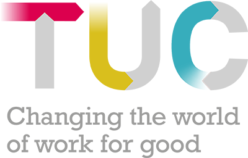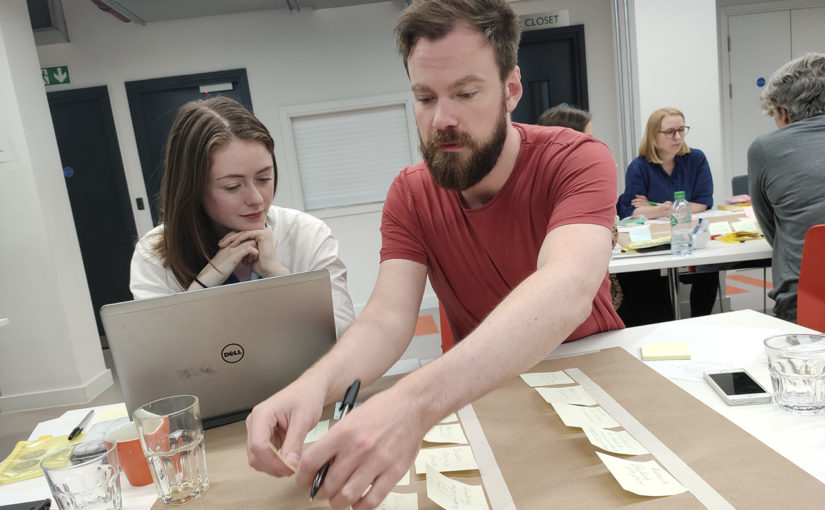At the end of June we convened the third session of the TUC Digital Lab, where we discussed and workshopped approaches to running successful ballots, with help from digital tools and design methods.
We began with a case study, presented by Nick McCarthy of PCS, who discussed their recent strike ballot campaign in the civil service (124,000 members affected in 290 workplaces).
Under the Trade Union Act, they needed to beat a 50% turnout threshold for the vote to be allowed. The issue at hand was a ‘offensive’ action, seeking a pay rise for staff after years of pay restraint (as opposed to a ‘defensive’ action such as preventing a cut in existing employment terms). In Nick’s experience, these types of ballots can harder to win, so required an even greater level of effort to achieve the 50% goal.
More widely, PCS had spent several months installing and setting up a new Salesforce implementation for the union. This brought significant new capabilities and tools for working with member data, but had only been in place for a few weeks when the ballot was called. So the campaign would have to take place while they were still finding their feet in the new system.
Furthermore, the union had previously run a ballot on the same issue and worker group which had achieved a turnout in the low 40s – there were some significant challenges to overcome.
Nick’s digital projects team straddles communications, digital and organizing. This gives him and his colleagues oversight of many key aspects required for a digitally-supported ballot.
(Note that we say digitally supported, because statutory ballots are still restricted to postal voting only. The role of digital in balloting is instead around making members aware of the vote, improving turnout and addressing logistical challenges such as lost ballot papers.)
To increase turnout, PCS focused on three areas.
First, they built an app using Salesforce to help track who had already voted. This meant reps could speak with members in the workplace, find out whether they had voted, and with a couple of taps on a mobile phone, send that data back to Salesforce. This allowed PCS to create an organising and communications programme tailored to motivate people who hadn’t yet voted.
The results were promising. Looking across all the branches taking part, greater use of the app by reps clearly correlated with a higher turnout in that branch. It wasn’t conclusive that the app itself increased turnout, it seems that reps were more engaged with the campaign.
Contacts with members was a kind of ‘game’ that reps could follow in real-time, as PCS reported the turnout numbers on a branch-by-branch basis, back to each rep. Some reps were even screenshotting the page of the app that showed the percentage of members reporting they’d voted and proudly sharing it on social with other activists.
Second, they invested in a peer-to-peer phone-banking tool, resulting in 130,000 calls to members. To do this, they used CallHub, an off-the-shelf product (which the company made available on EU servers for GDPR compliance purposes). Reps and volunteers were given basic level access to the tool, allowing them to log in and call members who hadn’t yet voted. The union recruited over 2,000 volunteers during the campaign, whose contact details were passed to their branch.
Nick’s team are keen to review the success of converting on-line volunteers into workplace activists, and will be following the volunteers to find out what they did. A future campaign would include more detailed plans for what to do with new volunteers and greater follow up with branches in engaging with them.
The third area Nick’s team focused on was creating a service to help reps order replacement ballot papers for members. The core insight was that lost ballots are a central pain point for members (who would previously have needed to contact ERS directly themselves to re-order, a significant barrier to participation).
The new mechanism had to meet the standards of an independent scrutineer (in that only the member can request a new paper, not anyone else), but was designed to streamline the process. After identifying that a member needed a new paper, the rep could quickly send them an email with a link to request it. When the member clicked the link, the system notified ERS and the ballot paper got posted out.
This was a real success. PCS even made the decision for ERS to switch to first class pre-paid post in the final two weeks of the campaign, rather than second class. This increased the cost of postage, but increased the probability of final votes arriving in time.
This is a key lesson for those of us working to improve digital services: How do we understand the things that are stopping members completing the tasks they set out to do? What can we do to make these tasks more straightforward?
The end result was unfortunately not what PCS had hoped for, with turnout still falling a fraction below 50%. The union got their best ballot turnout on record, and a significant rise over the previous ballot, but it still wasn’t quite enough on this occasion.
Despite this setback, there’s much for the movement to learn from their work. In Nick’s estimation, applying the lessons of this campaign in their next ballot could improve the results further, beating the Trade Union Act threshold. Enhancing paper ballots with digital campaign techniques should put more victories within reach.
Workshopping the problem
With this case study in mind, we then split into groups and the session moved into workshop mode.
The first exercise had participants working through the ‘spaghetti’ of their union’s technology. Organisations of all sizes use a wide range of systems to achieve their goals. These are often tangled, disconnected from one another and duplicative.
On a blank sheet of paper, we asked everyone to ‘draw their spaghetti’, in order to get an understanding of the way these systems are organised. This helps understand how things like member data move around, but also begins to uncover opportunities for cost-saving and improving processes.
With so much opportunity to improve members’ experience of the union still up for grabs, any analysis needs to include the underlying systems that help deliver that experience, not just the comms that we place over them.
Identifying the risks
The second exercise had us thinking about the risks to achieving a successful ballot. Here we are trying to reframe the things that worry us about a particular project into questions we must answer in order to avoid that risk.
In the case of balloting, most participants were concerned about the quality of member data held by the union. There were particular concerns that it would be out of date, meaning ballots get sent to the wrong place and potentially leaving the ballot open to legal challenge from the employer.
Having completed a list of questions for potential solutions to answer, we used stickers to vote on the most important ones, leaving us with a flipchart that looked like this:
Understanding the user experience
We took the approach of treating balloting as a product. Each group chose a convincing ballot scenario from one of their unions. We then looked at the product users (affected members), the series of tasks they must complete and touchpoints they must interact with in order to complete their ballot. Our 5 workshop groups acted like small product teams, making decisions about what features would best serve their users, and how to prioritise these.
To do this, we applied a technique known as User Story Mapping, to think about the ballot from the user’s perspective and to help us prioritise the areas where we might have the biggest impact in increasing turnout. This method has four steps.
First, we mapped the user journey of a typical user as they move through the campaign. For a ballot campaign, we considered the fact that this typical user is not a member who receives their ballot and immediately returns it. Instead, it’s a member who requires some prompts before they vote. We asked people to map out the steps in a ballot campaign over its six week duration, thinking about all of the different things that members might encounter along the way. These steps in the narrative are written on post-it notes and placed from left to right in chronological order.
The second step is to think again, this time about the journeys of other types of user. In this case, these might be members who have lost their ballot papers, or who aren’t particularly motivated to vote, or who work off-site and are hard to contact, or who may need additional help completing a traditional paper ballot. At each point, we asked the groups to add to the primary left to right story, building up a picture of areas where user needs combine or conflict.
The third step is to think about how you’d group the user’s tasks into similar activity. These master items help you think about the tasks members are trying to complete. In the case of balloting, most groups agreed the main themes for the user were:
- An indicative ballot or survey to get the views of members and to allow them to update their information
- Explanation of the ballot process and how to vote
- Get-out-the-vote messages
- Re-ordering lost ballots
- Reporting the result and next steps
The final step of user story mapping is to start to analyse the map for areas where new tools and processes could have the greatest possible impact. We all understand that unions don’t have the resources required to compete with large digital-first organisations. Instead we must prioritize our resources and use them wisely. User Story mapping helps you identify the spots where you can have most impact with limited resources. We asked participants to ‘thin out’ their map, to identify the things to prioritise. This typically left them with 1-2 areas to initially invest time in, before moving on to gradually more complex ideas.
In the end, the exercise showed us that there was a lot that could be achieved without needing new technology or expensive development. As has been a running theme of the Digital Lab so far, the use of cheap/ubiquitous tools, a user-centred process for designing and improving the services we offer members, an iterative approach to creating them, and placing a high value on ongoing planning and communication across teams, felt more important.
Further reading:
- Sprint (Jake Knapp) contains a method for designing and prototyping new products in a week. Any of the areas the groups decided to focus on (e.g. indicative ballots) would benefit from following this process. Moreover, the book contains useful exercises for rapid group decision making and testing new ideas. Really useful for a small team looking to make quick progress.
- User Story Mapping (Jeff Patton) is a much more detailed description of the method of understanding users, and meeting their needs, while factoring the capacity of an organisation to do so. It contains lots of useful examples, methods and case studies explaining how to prioritise tasks like an experienced Product Manager.
You can view the workshop slides here
Next workshops
The next workshop will follow on from some of the discussion on this theme, around the organising needed to underpin a successful ballot campaign. On 24 July, we’ll be looking at how we can use digital to enhance trade union organising. Sign up for this here.
Workshop write up by Sam Jeffers (The Shop) and John Wood, TUC Digital Lab.

